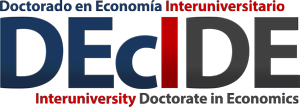- Referencia: Navarro-Azorín, J.M. y Artal-Tur, A.: “Foot voting in Spain: What do internal migrations say about quality of life in the Spanish municipalities?”. 2015, Social Indicators Research, 124 (2): 501–515..
In this paper we analyse the differences in well-being between Spanishmunicipalities reflected by people’s migratory decisions. It is assumed that people movefor improving their well-being conditions and consequently migratory flows basicallyreflect perceived differences in the quality of life between potential destinations. Ourempirical findings are: first, municipalities in the Mediterranean Axis are perceived asthose with the…
- Referencia: Martínez Pérez, J.E., Sánchez Martínez, F.I., Abellán Perpiñán, J.M. y Pinto Prades, J.L.: “La valoración monetaria de los costes humanos de la siniestralidad vial en Espa˜na”. 2015, Gaceta Sanitaria, 29(S1): 76-78.
Los análisis coste-beneficio en el ámbito de la seguridad vial han de computar la totalidad de los costes, y dentro de ellos ocupan un lugar clave los costes humanos. En esta nota se da cuenta de dos estudios promovidos por la Dirección General de Tráfico orientados a la obtención de valores oficiales para España de…
- Referencia: Sánchez, D.P., Guillén, J.J., Torres, A.M., Arense, J.J., López, A. y Sánchez, F.I.: “La recuperación del consumo farmacéutico tras la modificación del copago: evidencia de un servicio regional de salud”. 2015, Atención Primaria, 47(7): 411-418.
Objetivos: El objetivo de este estudio es evaluar el efecto de las políticas de copago farmacéutico en la cantidad y la tendencia de consumo de medicamentos. Diseño: Estudio observacional retrospectivo. Emplazamiento: Región de Murcia. Prescripción de medicamentos en atención primaria y especializada. Participantes: Registros correspondientes a las recetas dispensadas por las oficinas de farmacia entre…
- Referencia: Giménez-Gómez, J. M y Josep E. Peris: “From Bargaining Solutions to Claims Rules: a Proportional Approach”. 2025, GAMES, 6, 32-38 (2015).
Abstract: Agents involved in a conflicting claims problem may be concerned with the proportion of their claims that is satisfied, or with the total amount they get. In order to relate both perspectives, we associate to each conflicting claims problem a bargaining-in-proportions set. Then, we obtain a correspondence between classical bargaining solutions and usual claims…
- Referencia: Peris, J. E, Silva, J. A y Begoña Subiza: “Cost Sharing Solutions Defined by Non-Negative Eigenvectors”. 2025, European Journal of Operational Research, 244, 592-600 (2015).
Abstract: The problem of sharing a cost M among n individuals, identified by some characteristic ci in R+, appears in many real situations. Two important proposals on how to share the cost are the egalitarian and the proportional solutions. In different situations a combination of both distributions provides an interesting approach to the cost sharing…
- Referencia: Giménez-Gómez, J. M y Josep E. Peris: “Participation and solidarity in redistribution mechanisms”. 2025, The Czech Economic Review, 9, 36-48 (2015).DOI:
ABSTRACT Following Bossert (1995), we consider a model where personal income depends on two different characteristics: skills and effort. Luttens (2010) introduces claims that individuals have over aggregate income and that only depend on the effort they exert. Moreover, he proposes redistribution mechanisms in which solidarity is based on changes in a lower bound on…
- Referencia: Martínez-Soto, A. P y Susana Martínez-Rodríguez: “Graneries (pósitos): a source of finance for Spain´s small farmers, 1900-1950.»”. 2025, Continuity and Change. v. 30, n. 2, 251-277.
Abstract: Under the Ancien Régime in Spain local granaries (in Spanish, pósitos) acted as welfare institutions designed to help small farmers in times of crisis. During the first third of the twentieth century they were subject to an intense reorganisation in Spain and this transformed them into the only microfinance institution to which a significant part of the…
- Referencia: Macías, A y Mariano Matilla-García: “Net energy analysis in a Ramsey–Hotelling growth model”. 2015, Energy Policy, Volume 86, Pages 562-573.
Abstract: This article presents a dynamic growth model with energy as an input in the production function. The available stock of energy resources is ordered by a quality parameter based on energy accounting: the “Energy Return on Energy Invested” (EROI). In our knowledge this is the first paper where EROI fits in a neoclassical growth…
- Referencia: Faura, U, Lafuente, M, Matilla-García, M y M. Ruiz: “Identifying the Most Relevant Lag with Runs”. 2025, Entropy, 17(5):2706-2722.
ABSTRACT In this paper, we propose a nonparametric statistical tool to identify the most relevant lag in the model description of a time series. It is also shown that it can be used for model identification. The statistic is based on the number of runs, when the time series is symbolized depending on the empirical…
- Referencia: Matilla-García, M, Ruiz, M y Mohammed Dore: “A permutation entropy based test for causality: The volume–stock price relation’”. 2025, Physica A, 98, pp. 280-288 (2014).
ABSTRACT The purpose of this paper is to propose a newly developed non-parametric test for linear and nonlinear causality based on permutation entropy and to show its usefulness in analyzing the potential causal relationship between trading volume and security prices. Most of the empirical applications and tests for causality rely on using Granger causality based…

